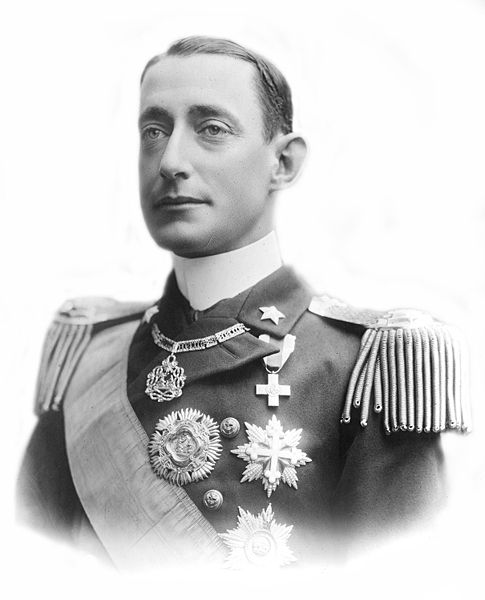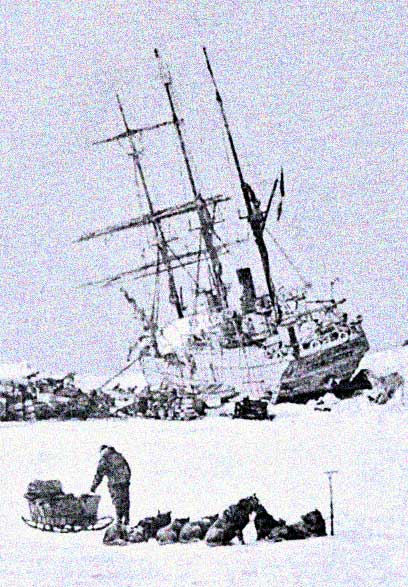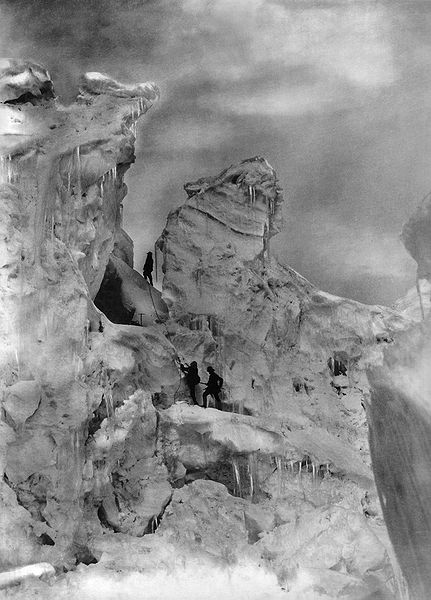<Back to Index>
- Explorer Prince Luigi Amedeo of Savoy-Aosta, Duke of the Abruzzi, 1873
- Dramatist Romain Rolland, 1866
- 25th President of the United States William McKinley, Jr., 1843
PAGE SPONSOR



Prince Luigi Amedeo of Savoy-Aosta, Duke of the Abruzzi (Luigi Amedeo Giuseppe Maria Ferdinando Francesco di Savoia-Aosta; 29 January 1873 – 18 March 1933), was an Italian prince, mountaineer and explorer. He is known for his Arctic explorations and for his mountaineering expeditions, particularly to Mount Saint Elias (Alaska - Yukon) and K2 (Pakistan - China). He also served as an Italian admiral during World War I.
Luigi Amedeo was a grandson of King Victor Emmanuel II of Italy. He was born in Madrid, Spain, during the brief period in which his father reigned as King Amadeo of Spain. Luigi Amedeo was the youngest of three sons born to Amedeo (otherwise known by his Italian title, Duke of Aosta) and his consort Maria Vittoria del Pozzo della Cisterna. Shortly after his birth his father, who had reigned in Spain since 1870, abdicated and returned to Italy. Luigi Amedeo was a member of the House of Savoy, well known in Europe since the 12th century. His uncle became King Umberto I of Italy in 1878, and his cousin became King Victor Emmanuel III in 1900. His ducal title was taken from the central Italian region of Abruzzo.
From 1893 to 1896 Luigi Amedeo travelled around the world, including Eritrea, then an Italian possession, and Vancouver. He had begun to train as a mountaineer in 1882 on Monte Bianco and Monte Rosa (Italian Alps): in 1897 he made the first ascent of Mount Saint Elias (Canada/U.S.,
5,489 m). There the expedition searched for a mirage that natives and
prospectors claimed to see over a glacier of what is called the Silent
City of Alaska. C.W. Thornton who was a member of the expedition
wrote, "It required no effort of the imagination to liken it to a city,
but was so distinct that it required, instead, faith to believe that it
was not in reality a city." Another witness wrote in The New York Times:
"We could plainly see houses, well-defined streets, and trees. Here and
there rose tall spires over huge buildings which appeared to be ancient
mosques or cathedrals." Some
think the mirage is an image of Bristol, England, that is 4,500 km
across the pole. Its ghostly image was reported each year between 21
June and 10 July. In 1899 Luigi Amedeo organized an expedition towards the North Pole. In spring he arrived in the Norwegian capital Christiania (the present day Oslo) with 10 companions. The duke acquired the Jason, a steam whaler of 570 tons. Renamed Stella Polare (“Pole Star”) the ship took the expedition through the frozen sea. On 12 June they headed for Archangel (Arkhangel’sk). On 30 June the Stella Polare dropped
anchor in the docks of Arkhangel’sk and the duke was solemnly received
by governor Engelhardt. The same day Luigi Amedeo was invited to meet
the local authorities and the present foreign diplomats. On 7 July a local newspaper wrote: Later
the duke himself wrote about his stay in Arkhangel’sk: "Our departure
was set for July 12. Early in the morning the church was open to us and
we, although being Catholic, were allowed to join the mass. In the
afternoon all the dogs were brought back on board to their kennels. In
the evening the Stella Polare put out and was escorted by two steamers down the Dvina.
I still remained on shore, as well as Doctor Cavalli, in order to spend
the evening together with our Italian friends. Next evening we left
Arkhangel’sk. During the whole journey we saw flags being hoisted to
welcome us…" Twenty
men took part in the expedition, among them Captain Umberto Cagni,
Lieutenant F. Querini and Doctor A. Cavalli Molinelli. They planned to
go to Franz Joseph Land, in the Arctic wilderness, to establish a camp in which to stay during
wintertime and, afterwards, to reach the North Pole by dogsled across
the frozen sea. Luigi Amedeo established the winter camp on the Rudolf Island.
The expedition was to start at the end of the Arctic Night. The duke
lost two fingers during winter because of the cold, which made it
impossible for him to join the trip by sled. He left the command over
the pole expedition to Captain Cagni. On 11 March 1900 Cagni left the
camp and reached latitude 86° 34’ on 25 April, setting a new record by beating Nansen’s result of 1895 by 35 to 40 kilometres. Cagni barely managed to turn back to the camp until June 23. On 16 August the Stella Polare left
the Rudolf Island heading south and the expedition returned to Norway.
During the expedition the northern coast of Rudolf Island and two other
islands were explored and measured. In 1906, inspired by Henry Morton Stanley's last wishes, the Duke led an expedition to the Ruwenzori Range (5,125 m), in Uganda. He scaled sixteen summits in the range, including the six principal peaks. One of them, Mount Luigi di Savoia, bears his name. The highest peak was reached on 18 June 1906. The next great expedition, in 1909, aimed to climb K2 in Karakorum.
A team led by Luigi Amedeo reached a height of 6,666 m on the ridge in
1909. The standard route up the mountain (formerly known as K2's East
Ridge) climbs today on the Abruzzi Spur. In an attempt on Chogolisa the next year he and his companions again failed to reach the summit, but set a world altitude record. A vice-admiral in the Italian Royal Navy (Regia Marina), he was Inspector of Torpedo Craft from 1911 to 1912. During World War I, he was the Commander in Chief of the Adriatic Fleet (1914 - 1917) based in Taranto, his flagship being the Conte di Cavour. Under the Duke, the Regia Marina was responsible for saving the Army of the Kingdom of Serbia. The Explorers Club in New York elected the Duke to its highest category of membership — Honorary Member — in 1912. The Duke assisted Italian dictator Benito Mussolini with the Italo-Ethiopian Treaty of 1928. He traveled to Addis Ababa with gifts. One gift, a Fiat 3000 tank, ended up playing a role in crushing the abortive coup d'état of 1928. In 1932, the Duke was briefly the President of the newly merged Italian Line. In
1931, combining all of Italy's transatlantic carriers into the Italian
Line was one of Mussolini's biggest business deals. However, the Duke
resigned soon after SS Rex broke down at Gibraltar. According to him, "My reason is that I have been unable to achieve
harmony among executives who formerly headed competing lines." The Duke of Abruzzi died on 18 March 1933, at Jowhar some ninety kilometres north of Mogadishu, Italian Somaliland. In 1920, he had founded here the "Village of the Duke of Abruzzi" (Villaggio Duca degli Abruzzi or Villabruzzi). The Villaggio Duca degli Abruzzi was
an agricultural settlement experimenting new cultivation techniques. By
1926, the colony comprised 16 villages, with 3,000 Somali and 200
Italian inhabitants, Italian Somalians.
In the early years of the twentieth century the Duke was in a relationship with Katherine Elkins, daughter of the wealthy American senator Davis Elkins, but the Duke's cousin King Vittorio Emmanuele III refused to grant him permission to marry a commoner. His brother, Emanuele Filiberto, to whom Luigi was very close to, convinced him to give up the relationship. In the later years of his life, the Duke married a young Somali woman named Faduma Ali.